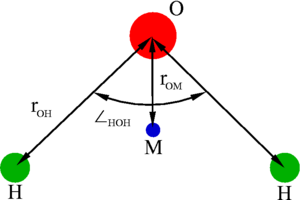TIP4P/2005 model of water: Difference between revisions
Jump to navigation
Jump to search
m (Link to an external resource) |
m (Changed references to Cite format.) |
||
| Line 1: | Line 1: | ||
The '''TIP4P/2005''' model | The '''TIP4P/2005''' model | ||
<ref>[http://dx.doi.org/10.1063/1.2121687 J. L. F. Abascal and C. Vega "A general purpose model for the condensed phases of water: TIP4P/2005", Journal of Chemical Physics, '''123''' 234505 (2005)]</ref> | |||
is a re-parameterisation of the original [[TIP4P]] potential for simulations of [[water]]. | |||
TIP4P/2005 is a rigid planar model, having a similar geometry to the Bernal and Fowler ([[BF]]) model. | TIP4P/2005 is a rigid planar model, having a similar geometry to the Bernal and Fowler ([[BF]]) model. | ||
==Parameters== | ==Parameters== | ||
| Line 26: | Line 28: | ||
*[http://dx.doi.org/10.1063/1.2925792 Thomas E. Markland, Scott Habershon, and David E. Manolopoulos "Quantum diffusion of hydrogen and muonium atoms in liquid water and hexagonal ice", Journal of Chemical Physics '''128''' 194506 (2008)] | *[http://dx.doi.org/10.1063/1.2925792 Thomas E. Markland, Scott Habershon, and David E. Manolopoulos "Quantum diffusion of hydrogen and muonium atoms in liquid water and hexagonal ice", Journal of Chemical Physics '''128''' 194506 (2008)] | ||
==References== | ==References== | ||
<references/> | |||
'''Related reading''' | |||
*[http://dx.doi.org/10.1063/1.2215612 C. Vega, J. L. F. Abascal and I. Nezbeda, "Vapor-liquid equilibria from the triple point up to the critical point for the new generation of TIP4P-like models: TIP4P/Ew, TIP4P/2005, and TIP4P/ice", Journal of Chemical Physics, '''125''' 034503 (2006)] | |||
*[http://dx.doi.org/10.1039/b812834k J. L. Aragones, M. M. Conde, E. G. Noya and C. Vega "The phase diagram of water at high pressures as obtained by computer simulations of the TIP4P/2005 model: the appearance of a plastic crystal phase", Physical Chemistry Chemical Physics '''11''' pp. 543- (2009)] | |||
==External links and resources== | ==External links and resources== | ||
*[http://emoles.quim.ucm.es/pdf/aiche_talk_web.pdf Presentation: Comparing the performance of TIP4P/2005 with other water models] | *[http://emoles.quim.ucm.es/pdf/aiche_talk_web.pdf Presentation: Comparing the performance of TIP4P/2005 with other water models] | ||
Revision as of 16:01, 11 May 2009
The TIP4P/2005 model [1] is a re-parameterisation of the original TIP4P potential for simulations of water. TIP4P/2005 is a rigid planar model, having a similar geometry to the Bernal and Fowler (BF) model.
Parameters

| (Å) | HOH , deg | (Å) | (K) | q(O) (e) | q(H) (e) | q(M) (e) | (Å) |
| 0.9572 | 104.52 | 3.1589 | 93.2 | 0 | 0.5564 | -2q(H) | 0.1546 |
Phase diagram
The phase diagram of the TIP4P/2005 model is given in a publication by Abascal, Sanz and Vega.
Surface tension
The surface tension has been studied for the TIP4P/2005 model by Vega and Miguel.
Self-diffusion coefficient
The TIP4P/2005 potential has a self-diffusion coefficient, in bulk water at 298 K, of 0.21 Å2 ps−1 in a classical simulation of 216 water molecules (experimental value: 0.23 Å2 ps−1).
References
Related reading
- C. Vega, J. L. F. Abascal and I. Nezbeda, "Vapor-liquid equilibria from the triple point up to the critical point for the new generation of TIP4P-like models: TIP4P/Ew, TIP4P/2005, and TIP4P/ice", Journal of Chemical Physics, 125 034503 (2006)
- J. L. Aragones, M. M. Conde, E. G. Noya and C. Vega "The phase diagram of water at high pressures as obtained by computer simulations of the TIP4P/2005 model: the appearance of a plastic crystal phase", Physical Chemistry Chemical Physics 11 pp. 543- (2009)




